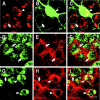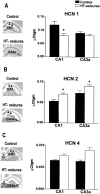Developmental febrile seizures modulate hippocampal gene expression of hyperpolarization-activated channels in an isoform- and cell-specific manner
- PMID: 12040066
- PMCID: PMC3372984
- DOI: 10.1523/JNEUROSCI.22-11-04591.2002
Developmental febrile seizures modulate hippocampal gene expression of hyperpolarization-activated channels in an isoform- and cell-specific manner
Abstract
Febrile seizures, in addition to being the most common seizure type of the developing human, may contribute to the generation of subsequent limbic epilepsy. Our previous work has demonstrated that prolonged experimental febrile seizures in the immature rat model increased hippocampal excitability long term, enhancing susceptibility to future seizures. The mechanisms for these profound proepileptogenic changes did not require cell death and were associated with long-term slowed kinetics of the hyperpolarization-activated depolarizing current (I(H)). Here we show that these seizures modulate the expression of genes encoding this current, the hyperpolarization-activated, cyclic nucleotide-gated channels (HCNs): In CA1 neurons expressing multiple HCN isoforms, the seizures induced a coordinated reduction of HCN1 mRNA and enhancement of HCN2 expression, thus altering the neuronal HCN phenotype. The seizure-induced augmentation of HCN2 expression involved CA3 in addition to CA1, whereas for HCN4, mRNA expression was not changed by the seizures in either hippocampal region. This isoform- and region-specific transcriptional regulation of the HCNs required neuronal activity rather than hyperthermia alone, correlated with seizure duration, and favored the formation of slow-kinetics HCN2-encoded channels. In summary, these data demonstrate a novel, activity-dependent transcriptional regulation of HCN molecules by developmental seizures. These changes result in long-lasting alteration of the HCN phenotype of specific hippocampal neuronal populations, with profound consequences on the excitability of the hippocampal network.
Figures






References
-
- Bender RA, Baram TZ. Do prolonged febrile seizures injure hippocampal neurons? Insights from animal models. In: Baram TZ, Shinnar S, editors. Febrile seizures. Academic; San Diego: 2002. pp. 127–137.
-
- Bender RA, Dubé C, Baram TZ. Mossy fiber sprouting into the inner molecular layer of the dentate gyrus follows prolonged febrile seizures in the immature rat model. Epilepsia. 2000;41 [Suppl 7]:76.
-
- Bender RA, Brewster A, Santoro B, Ludwig A, Hofmann F, Biel M, Baram TZ. Differential and age-dependent expression of hyperpolarization-activated, cyclic nucleotide-gated cation channel isoforms 1–4 suggests evolving roles in the developing rat hippocampus. Neuroscience. 2001;106:689–698. - PMC - PubMed
-
- Biervert C, Schroeder BC, Kubisch C, Berkovic SF, Propping P, Jentsch TJ, Steinlein OK. A potassium channel mutation in neonatal human epilepsy. Science. 1998;279:403–406. - PubMed
Publication types
MeSH terms
Substances
Grants and funding
LinkOut - more resources
Full Text Sources
Miscellaneous
